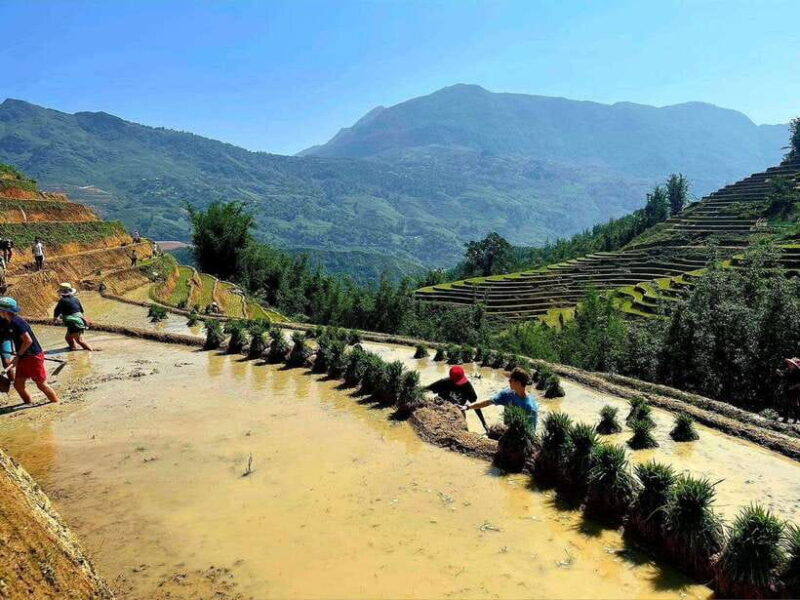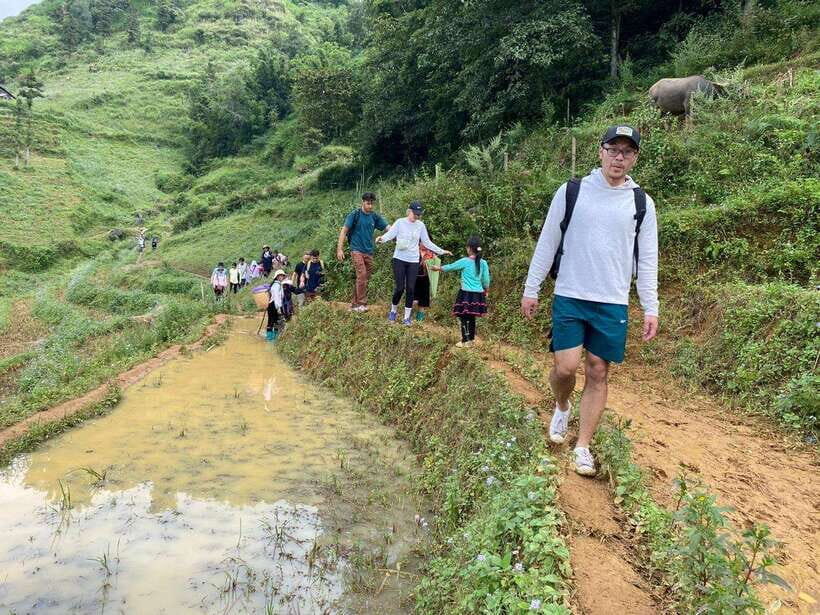A two-day journey into the heart of Northern Vietnam, exploring Sapa’s breathtaking scenery and diverse ethnic cultures. For just $106, you’ll travel from Hanoi aboard a comfortable VIP sleeper bus, then trek through lush rice paddies, visit minority villages, and stay overnight in a traditional homestay or hotel.
What we love about this trip is how it combines accessible transportation with authentic local experiences—like cooking with villagers and wandering through bustling markets. The chance to see Fansipan, Vietnam’s highest peak, from afar is an added bonus, along with the genuine insight into the daily lives of ethnic minorities such as the H’mong, Dzay, and Dzao.
One potential consideration is the travel time—about 6 to 7 hours each way on the sleeper bus—which can be tiring after a long day of sightseeing. Still, this is a small price to pay for the chance to escape Hanoi’s chaos and step into a world of terraced fields and mountain villages.
This tour suits travelers who enjoy culture, stunning landscapes, and are comfortable with basic homestays or hotel accommodations. If you’re looking for a no-fuss way to experience Sapa’s highlights without a multi-day commitment, this is a solid choice.
Key Points
- Comfortable Transfer: Travel in style on a VIP sleeper bus with amenities like Wi-Fi.
- Authentic Encounters: Meet and chat with local ethnic minorities, gaining insights into their daily lives.
- Scenic Trekking: Experience stunning views of rice terraces, Fansipan, and lush valleys.
- Cultural Immersion: Visit traditional villages, markets, and stay overnight in a homestay or hotel.
- Flexible Options: Choose between staying in a basic homestay or a more comfortable hotel.
- Value for Money: At $106, it packs in transportation, guided tours, meals, and cultural experiences.
Exploring Sapa in Style and Substance: A 2-Day Trekking Adventure

For many travelers, Vietnam’s northern highlands are a highlight—a patchwork of terraced rice paddies, rugged mountains, and vibrant ethnic communities. This 2-day trekking tour from Hanoi offers an inviting way to experience those treasures without the hassle of planning every detail. We’ll break down what you can expect, what makes it special, and how to decide if it’s the right fit.
Love the outdoors? Here are other hiking experiences we've covered in Ta Van
Starting Point: Comfortable and Convenient Transportation
Your adventure begins early, with a pickup around 6:20-6:30 am from your Hanoi Old Quarter hotel. The company’s VIP sleeper bus promises a more comfortable journey than standard coach options, with air conditioning, Wi-Fi, and a travel blanket to help you rest. After approximately six hours on the road, you arrive in Sapa, ready to start exploring.
Traveling by sleeper bus is a common choice in Vietnam, and it’s a good way to maximize your time. While the journey is long, the comfort level and the opportunity to sleep or relax en route make it more appealing. Plus, arriving fresh in Sapa means you’re ready to hit the trails.
The Treks and Scenic Highlights
Once in Sapa, your itinerary splits into two options: staying in a homestay or a hotel. Both include a guided trek through some of the most iconic sights.
Day 1: From Hanoi to the Muong Hoa Valley and Black H’mong Villages
The first day involves an 11-kilometer trek through the Muong Hoa Valley, renowned for its terraced rice paddies and panoramic views of Fansipan, Vietnam’s highest mountain. The guide, often a local from the nearby villages, enriches the walk with insights into the various ethnic groups you’ll encounter.
You’ll visit Y Linh Ho, home to the Black H’mong people. Here, you’ll see traditional costumes—indigo-dyed indigo skirts, embroidered shirts—and perhaps chat with villagers about their daily routines. We loved the chance to peek inside traditional wooden houses, which feel like stepping into a living museum.
Passing through Lao Chai and Ta Van villages, you’ll see more ethnic minorities and learn how they cultivate rice and sustain their livelihoods. Here, the scenery is mesmerizing—rice paddies cascading down mountain slopes, with Fansipan looming in the distance.
Overnight: in a homestay shared with the Dzay ethnic family or in a hotel. Staying with a local family offers a rare glimpse into daily life and a chance to bond over a simple meal.
Day 2: Mountain Trails and Waterfalls
The second day takes you on an 8-kilometer trek, starting with breakfast at your accommodation. The trail passes through a bamboo forest—a cool, shady respite—and leads to a waterfall where you might take a quick swim.
You’ll walk along the Muong Hoa River, crossing small bridges and passing more tribal villages. The scenery here is all about mountain vistas and lush greenery, perfect for photos and reflection.
Lunch is served at a local restaurant, offering authentic regional dishes. Afterwards, you’ll head back to Sapa town for some free time—perhaps exploring the market, where you can buy textiles, handicrafts, and souvenirs.
Authentic Experiences and Cultural Touchpoints
One thing that sets this tour apart is its emphasis on connecting travelers with local communities. You’ll see traditional costumes, learn about different ethnic customs, and interact with villagers who are eager to share their way of life.
Reviewers particularly appreciated the chance to “see how locals live in an authentic way” and enjoy “beautiful views of Fansipan mountain and rice paddies.” The opportunity to cook together with your host or wander through Sapa’s bustling markets adds depth to the experience.
More Great Tours NearbyPractical Details: What’s Included and What to Consider
The tour’s price of $106 per person covers transportation, guided treks, entrance fees, and meals. The choice between homestay and hotel accommodation influences comfort levels but not the core experience.
Homestays are basic but genuine; don’t expect luxury, but do expect warmth and culture. Some reviews mention that facilities are “simple,” and that’s part of the charm—these stays are about engaging with local life, not luxury amenities.
Choosing a hotel adds a touch of comfort—more private bathrooms, better beds—which might be preferable if you’re sensitive to basic facilities. The tour allows you to select your preferred lodging at booking.
The included meals are regional and straightforward, offering a taste of local flavors. As one reviewer noted, “the food was delicious and filling after a day on the trails.”
While in Ta Van, here are other experiences we've covered
Transportation and Timing
The sleeper bus’s schedule is designed to maximize your time in Sapa, arriving early morning and returning late at night. This means you get two days of activity but should be prepared for a long travel day. The bus’s amenities and the chance to relax or sleep make the journey manageable.
Note that the itinerary can change due to weather or operational conditions, so flexibility is key. This is especially true in Sapa, where weather can be unpredictable—cold, foggy, or rainy from September to March. Packing warm clothes, including a jacket, scarf, and hat, is essential.
Who Will Love This Tour?
This trip appeals to those who enjoy cultural encounters, scenic views, and manageable trekking. It’s perfect for travelers who want an authentic experience without the commitment of a multi-day expedition. It’s less suited for people with limited mobility, children under six, pregnant women, or anyone over 70, given the physical nature of the activities.
Final Thoughts: Is It Worth It?

If you’re after an affordable, well-organized way to see Sapa’s iconic rice terraces, ethnic villages, and mountain vistas, this tour delivers. The blend of guided treks, local interaction, and overnight stays creates a rich, memorable experience that balances comfort with authenticity.
You’ll love the stunning views, the chance to meet ethnic minority people, and the genuine warmth of staying in a homestay or hotel. The long travel hours are a consideration, but the scenic rewards and cultural insights make it worthwhile.
This tour is best suited for adventurous travelers eager to step outside Hanoi’s urban vibe and into the natural beauty and vibrant cultures of northern Vietnam. It’s a worthwhile investment for anyone looking to capture the essence of Sapa without breaking the bank.
FAQ

What is the transportation like?
You’ll travel from Hanoi to Sapa on a VIP sleeper bus that offers air conditioning, Wi-Fi, and a travel blanket, making the long ride more comfortable. The return journey is also by sleeper bus.
How long is the trekking?
Day 1 involves an 11-kilometer trek through the Muong Hoa Valley, and Day 2 features an 8-kilometer hike, both on dirt trails and through scenic villages.
What should I bring?
Comfortable shoes, a sun hat, sunscreen, and warm clothing—especially in cooler months—are recommended. The weather can be unpredictable, so layers are wise.
Are homestays basic?
Yes, homestays are simple but authentic, with basic facilities. They offer a genuine glimpse into local life, which many travelers appreciate.
Can I choose between homestay and hotel?
Yes, at booking you can select your preferred accommodation type, balancing comfort and culture.
Is this suitable for families?
Not for children under six or travelers with limited mobility. The trekking and basic facilities may not be suitable for very young children or those with mobility issues.
How flexible is the schedule?
The itinerary can change due to weather or operational factors, so some flexibility is advised. The tour provider offers a full refund if canceled 24 hours in advance.
This 2-day Sapa trekking tour combines scenic beauty, cultural discovery, and manageable adventure, making it a memorable way to experience Vietnam’s northern highlands. Whether you stay in a cozy homestay or a comfortable hotel, the experience promises genuine connections and views you won’t forget.
You can check availability for your dates here:More Hiking & Trekking Tours in Ta Van
More Tours in Ta Van
More Tour Reviews in Ta Van
- Hanoi: 3 Days Sapa- Trekking Cat Cat, Lao Chai,Glass Bridges
- Sa Pa One-Day Trek through Ethnic Villages & Rice Terraces
- SAPA 2 Day trekking & 1 night Homestay with LOCAL PEOPLE
- From Hanoi: Sapa 2D1N Hotel overnight by Morning bus
- From Hanoi: Visit Sapa 3 Days & See The Terraced Fields
- Hanoi: 3-Day Sapa-Fansipan-Cat Cat Village Group Tour by Bus
More Ta Van experiences we've covered
- Hanoi: 3 Days Sapa- Trekking Cat Cat, Lao Chai,Glass Bridges
- Sa Pa One-Day Trek through Ethnic Villages & Rice Terraces
- SAPA 2 Day trekking & 1 night Homestay with LOCAL PEOPLE
- From Hanoi: Sapa 2D1N Hotel overnight by Morning bus
- From Hanoi: Visit Sapa 3 Days & See The Terraced Fields
- Hanoi: 3-Day Sapa-Fansipan-Cat Cat Village Group Tour by Bus
- From Hanoi: Explore Sapa & Local Village 3 Days
- 3-Day Sa Pa Trek: Villages, Rice Terraces & Bamboo Forest
